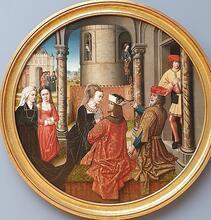Athaliah: Midrash and Aggadah
"The Death of Athaliah," by Gustave Doré, 1866. From Doré's English Bible via Wikimedia Commons.
Athaliah was one of the few women to rule Israel, which she did for six years. She was very powerful and is described as evil, as she erased traditional customs and executed almost all of the members of the Davidic lineage.
Article
The Rabbis state that Athaliah was one of the four women who wielded the scepter, two of whom ruled over Israel (Jezebel and Athaliah) and two over other peoples (the heathen Semiramis and Vashti) (Esther Rabbah 3:2). During the six years of her reign, Athaliah, who was wicked, wielded great influence over the Temple rite and the spiritual state of the people. Her sons introduced licentiousness and idolatry into the Lord’s House and the A type of non-halakhic literary activitiy of the Rabbis for interpreting non-legal material according to special principles of interpretation (hermeneutical rules).Midrash relates that they removed the gold nails of the Temple (Ex. Rabbah 40:3). Because of their malicious actions, Jehoash was compelled to repair the Temple as soon as he ascended the throne (Seder Olam Rabbah 24).
During the reign of Athaliah, the name of the Holy One, blessed be He, left people’s mouths, and they ceased greeting one another in the name of the Lord—“The Lord be with you”—as had been customary since the time of Boaz (Ruth Rabbah 4:4:5). Athaliah almost totally eliminated the Davidic line, except for Joash, who was saved from her sword, thanks to the blessing of the women to Naomi: “Blessed be the Lord, who has not withheld a redeemer from you today!” (Ruth 4:14). The Rabbis understood this blessing to mean that, just as Naomi has a redeemer today, so, too, there will always be a monarch in Israel from among the descendants of King David. Athaliah’s plot to extirpate the Davidic dynasty failed, by merit of the blessing given it by other women (Ruth Rabbah 4:14:15).
Many artists have referenced the story of Athaliah in their work, notably the tragic play Athalie by Jean Racine, written in the late seventeeth century. Racine drew from both biblical and Greek sources to create a somber tone and a play that is often considered one of the best French dramas. An oratorio by Frideric George Handel in the early eighteenth century is based on Racine’s play, during the period that Athalie became popular and renowned in western Europe.
Dutcher-Walls, Patricia. “Athaliah.” & Dutcher-Walls, Patricia, Roxanne Lalande, Martin Lockshin, Nils Holger Petersen, and Gina Strumwasser. “Athaliah (Queen of Judah).” Encyclopedia of the Bible and Its Reception online resource.
Gafney, Wilda C. Womanist Midrash: A Reintroduction to the Women of the Torah and the Throne. Westminster John Knox Press, 2017.
Handel, George Frideric. Athalia. 1733.
Klein, Reuven Chaim Rudolph. "Queen Athaliah: The Daughter of Ahab or Omri?." Jewish Bible Quarterly 42, no. 1 (2014): 11-20.
Racine, Jean. Athalie. Macmillan, 1901.
This book is an annotated script of the play written by Jean Racine in 1691, originally in French.
Scales, Joseph, and Cat Quine. "Athaliah and Alexandra: Gender and Queenship in Josephus." Journal of Ancient Judaism 1, no. aop (2020): 1-18.











